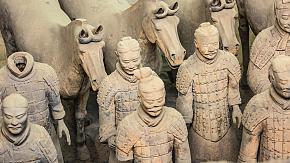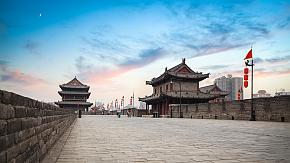Xi'an Emperors: Huangdi, Qin Shihuang, Wu Zetian
From the Qin Dynasty to the Tang Dynasty, 62 emperors ruled China from Xi'an. There are three interesting emperors that we would like to introduce to you to enrich your Xi'an tours.
The Father of the Chinese Nation - Huangdi (Yellow Emperor)
Huangdi was the legendary ancestor of the Chinese nation and is considered the founder of Chinese civilization. Chinese people often refer to themselves as the descendants of Huangdi.
About 5,000 years ago, Huangdi was the chief of one of the strongest tribes in the middle valley of the Yellow River. At that time, the Yellow River Valley was an agricultural center and many tribes came to settle around the valley, engaging in farming. It is said that Huangdi unified those tribes and was made chief of the tribal union, thus named Huangdi (Yellow Emperor), after the yellow color of the earth, the symbol of farming.
If you would like to know more about this Emperor, the Mausoleum of Huangdi is a good place to go. It is located in Huangling County, about 180 km north of Xi'an, and is known as the most important ancient grave in China.
The First Emperor of China - Emperor Qin Shihuang
Qin Shihuang was the first emperor of the Qin Dynasty (221-206 BC). He wiped out six different states and established the first centralized feudal state in the history of China with Xi'an as the capital. Without him, it might not be possible for us to experience the fascinating Great Wall. Without him, we might not have had the chance to give a gasp to the life-size warriors who were dressed and appeared ready to battle.
During his reign, Qin Shihuang had many achievements, such as working out a uniform code of law, standardized currency, weight and measures, and even written language. Nevertheless, the most mysterious thing that he had left for us was his eternal resting place, the largest mausoleum in China. It took 700,000 people 36 years to build this luxurious underground tomb. Nobody knows the actual structure and position of the mausoleum. It is said that there are over 8,000 warriors in his tomb, as well as tens of thousands of statues, and treasures undoubtedly still remain to be unearthed.
If you want to know more about the emperor, there are two places you can visit: the Museum of Terracotta Warriors & Horses, and the underground palace of Qin Mausoleum.
 Terra Cotta Warriors, Xi'an
Terra Cotta Warriors, Xi'an
The First Female Emperor - Wu Zetian
The Tang Dynasty (618-906 AD) was a time of relative freedom for women. It was a time in which a number of exceptional women contributed in the areas of culture and politics. Emperor Wu Zetian of the Tang Dynasty was the first and the only female Emperor in Chinese history and ruled the empire for over half a century. She had acted no different than most male emperors of her day and managed to effectively rule China and made great achievements in many areas.
She was not double the most remarkable and famous woman in Chinese history. If you ask a five-year-old Chinese girl about Wu Zetian, she might be able to tell you a whole legend of this Emperor. Many TV shows are featuring her life and paying great attention to this mysterious woman, thus almost everybody knows about Wu Zetian and her story.
If you like to know more about her, Qianling Tomb can be your best choice. It is 80 km from Xi'an. It is the Joint tomb of Tang Emperor Gaozong and Empress Wu Zetian.
Contact us and tailor-make a China tour.
What Our Clients Say
"Great Customized Service", "Trip of A Lifetime", "Exceed All Expectations"




